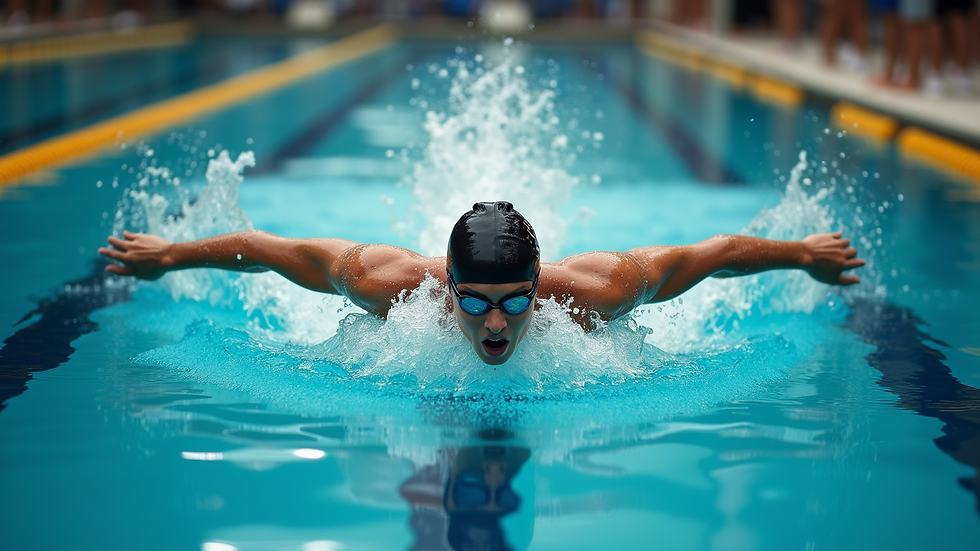Swim Smart: How to Build Resilience in the Pool
- Dr Paul McCarthy

- Jul 30
- 4 min read
Swimming is more than just a sport; it's a mental challenge that requires concentration, discipline, and resilience. Swimmers face a variety of challenges, including competition pressure and training fatigue. So, how can athletes rise above these trials? The answer lies in building swim resilience through a swimming mindset that enhances mental toughness swimming. In this blog post, we’ll explore practical techniques to nurture resilience in the pool, helping you overcome fears, tackle setbacks, and thrive under pressure.
Understanding Swim Resilience
Swim resilience means an athlete's ability to recover from setbacks, adapt to challenges, and keep a positive outlook. This trait is vital not just for competitive swimmers but for anyone who enjoys the water. A strong swimmer mindset can significantly boost performance levels and emotional stability during competitions.
Swim resilience is not merely about holding up under pressure. It's about a swimmer's ongoing journey of growth, even when faced with difficulties. Developing psychological skills for swimmers forms the cornerstone of a rewarding swimming experience.
The Importance of a Swimming Mindset
A strong swimming mindset can drastically influence performance. This mindset includes beliefs and attitudes that shape how athletes engage with training and competition. A positive approach allows swimmers to avoid burnout and face challenges head-on.
By focusing on the process of swimming rather than solely on outcomes, athletes can learn to embrace challenges as opportunities for growth. For instance, a swimmer who finishes fifth in a race can analyze their performance to find areas for improvement, turning what might feel like a defeat into a stepping stone for future success.
Techniques for Building Resilience in the Pool
Goal Setting
Setting specific and achievable goals is a powerful resilience-building tool. Using the SMART criteria—Specific, Measurable, Achievable, Relevant, and Time-bound—helps swimmers break down bigger ambitions into manageable tasks. For example, instead of aiming to "swim faster," set a goal to improve your 100-meter time by two seconds within three months.
This systematic approach helps swimmers track their progress and celebrate small victories, which boosts motivation. A competitive swimmer might aim for a weekly training goal, such as mastering a specific stroke or endurance level, while a recreational swimmer might target swimming a certain distance without stopping.
Visualization
Visualization is an impactful technique for enhancing swim mental training. When swimmers mentally rehearse various scenarios—like winning a race or completing a challenging training session—they help build confidence and prepare both their minds and bodies for real-life challenges.
For instance, a swimmer might visualize the start of a race, the sound of the starting gun, and the feel of the water as they push off. These mental practices can lead to better performance on race day, as they've already experienced success in their minds.

Positive Self-Talk
What athletes say to themselves can significantly shape their mindset. Practicing positive self-talk—a key part of effective resilience techniques for athletes—can counter negative emotions. Swimmers should create affirmations like "I am strong, I am capable" to uplift themselves during tough times or laps.
Integrating this practice into daily routines can strengthen mental toughness. Research shows that athletes who engage in positive self-talk improve their performance by up to 22%. Consistency in using positive language can make a real difference.
Embracing Failure
Accepting failure is crucial for building mental strength in competitive swimming. By reinterpreting setbacks as natural parts of their journey, swimmers can diminish the fear linked with poor performances.
Instead of fearing a poor lap time, athletes can see it as a chance to learn and evolve. A swimmer might discuss a disappointing performance with their coach to pinpoint what went wrong, reinforcing a community of shared growth and resilience.
Coping with Swim Performance Anxiety
Performance anxiety can affect even the most experienced swimmers. Understanding and managing these feelings is essential for maintaining focus. Techniques may include using deep breathing exercises, mindfulness, and pre-race routines that help center athletes.
Incorporating principles of emotional resilience in sport equips swimmers with strategies to handle pressure better. For example, practicing a brief meditation before a race can help normalize high-stress moments and enhance performance.
Building Emotional Connections
To foster emotional resilience in swimming, it’s key to build connections within the swimming community. Nurturing relationships with coaches, teammates, and mentors can provide a support network bolstered by shared experiences and encouragement.
Open conversations about feelings, victories, and setbacks can help foster a sense of belonging. For instance, a team might hold regular meetings where members share their challenges and successes, which can enhance resilience and mental strength.
Final Thoughts
Developing resilience in the pool is an invaluable skill for every swimmer. By focusing on enhancing your swimming mindset, setting achievable goals, utilizing visualization, embracing failure, and managing performance anxiety, athletes can significantly elevate their performance and enjoyment in swimming.
Adopting these psychological skills for swimmers not only enhances competition results but also encourages personal growth and stability in and out of the pool. Remember, every stroke you take presents an opportunity to build resilience and push beyond your limits. So take the plunge, embrace each trial, and swim smart!




